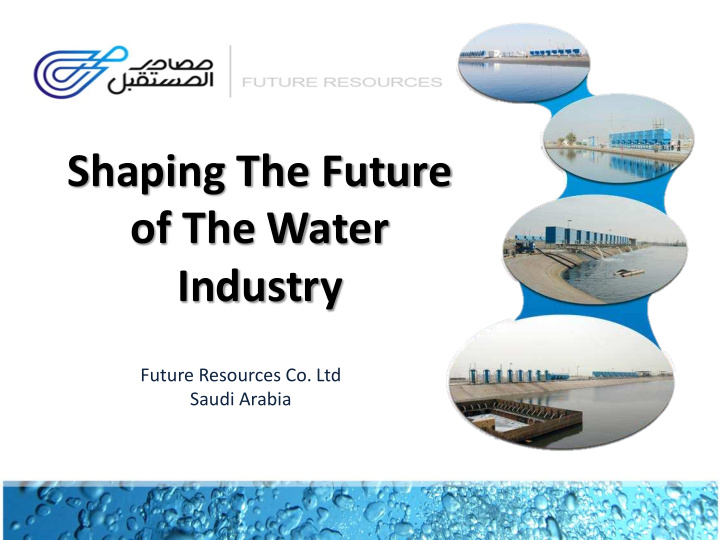



Shaping The Future of The Water Industry Future Resources Co. Ltd Saudi Arabia
THE UGLY THE GOOD
DISTRIBUTION OF EARTH’S WATER
NO CHEMICALS
OFR Technology THE DADI Technology HYDROXYL RADICAL
THE HYDROXYL RADICAL The hydroxyl radical, OH·, is the neutral form of the hydroxide ion (OH–). Hydroxyl radicals are highly reactive and consequently short- lived; however, they form an important part of radical chemistry. Most notably hydroxyl radicals are produced from the decomposition Molecular orbital of the hydroxyl radical of hydro-peroxides (ROOH) or, in with unpaired electron atmospheric chemistry, by the reaction of excited atomic oxygen with water.
HYDROXYL EFFECTS ON ORGANICS The hydroxyl radical is often referred to as the "detergent" of the troposphere because it reacts with many pollutants, often acting as the first step to their removal. It also has an important role in eliminating some greenhouse gases like methane and ozone. The high oxidizing property of ·OH radicals is highly effective in breaking down long organic chains.
HYDROXYL APPLICATION IN OUR TECHNOLOGIES OFR TECHNOLOGIES DADI TECHNOLOGIES
OFR Technology THE DADI Technology HYDROXYL RADICAL
1. Static Hydro Reactor (SHR) The Static Hydro Reactor is a proprietary design that utilizes proprietary multi-function media modules and compressed air to breakdown and treat specific pollutants in wastewater. SHR is ideal for: • Removal of dissolved/emulsified mineral oil & grease. • Removal of surfactants (detergent, soap, raw materials from cosmetics ). • Removal of solvent. • Removal of heavy metals. • Removal of aromatic compounds including benzene, ethy-benzene and xylene etc.
2. Dynamic Hydro Reactor (DHR) Solution for the cost effective treatment of high concentration organic pollutants from waste water. DHR is ideal for: • Breakdown of Long Chain Hydrocarbon • Removal of soluble COD ( non biodegradable) • Removal of cyanide • Removal of pesticides • Removal of dioxin • Removal of ammonia • Disinfection etc
OFR Technology THE DADI Technology HYDROXYL RADICAL
APPLICATIONS OF DADI TECHNOLOGY • Desalination UF and thermal Plant Reject Recovery • High TDS ( >300,000 ppm) Reduction • Industrial Wastewater • Spent caustic treatment and regeneration • Heavy metal removal and recovery ADVANTAGES OF DADI TECHNOLOGY • Low energy consumption • Environmentally Friendly • Very robust and Flexible system design and configuration Generates Revenue • • Reduced maintenance and operation costs
DADI TECHNOLOGY High TDS _ + _ + _ + _ + + _ + + _ + _ + _ + _ + _ NaOH Very Low TDS HCl
OXIDATION TECHNOLOGY COMPARISON Our Tech. WAO Ozone Fenton Temp Normal High > 200 No No Pressure No High 2- 30 Bar No No Chemical No No No Extensive Hazard No Yes yes yes Power Low DC High High Low Capex Low V. High High High Opex Low V. High V. High V. High Flexibility Flexible Modules Batch Process Difficult Difficult Op Safety Safe Dangerous Toxic Toxic By Product Waste the Wealth No Partial Oxidation Sludge Life Span 20 years Corrosive less life Corrosive less life High Maintenance Oxidation OH. OH. O3 H2O2 strength Normal Condition Extreme Condition low Oxidation low Oxidation
EXAMPLES OF TEST RESULTS
INDUSTRIAL WASTE WATER DADI UNIT Before Treatment After Treatment Ammonia 8,250 mg/L 14.9 mg/L Ammonia Removal Ammonia 4,190 mg/L 45.2 mg/L Ammonia 40 mg N/L 0.4 mg N/L Chloride 17 ppm 8 ppm Cooling Tower (Blow Down) Turbidity 208 3 Phosphorus 3 mg/L 0.2 mg/L High COD COD 1,600 mg/L 29.6 mg/L
HEAVY METALS & SPENT CAUSTIC Source Parameters Before Treatment After Treatment Iron 3 ppm 0.1 ppm Zink 18 ppm < 0.05 ppm Industrial Waste Water Zirconium 41 ppm 0.189 ppm Aluminum 19,000 ppm 1,900 ppm Source Parameters Before Treatment After Treatment 0.02% in water Zirconium recovery LAO Spent Caustic 40.58 % percentage 84% in Powder after Dry
SPENT CAUSTIC Source Parameters Before Treatment After Treatment TDS (mg/L) 52,915 7,213 TOC (mg/L) 5,135 792 Salty Stream Phenol ( mg/L) 22.28 < 0.1 TSS (mg/L) 220 42 Source Parameters Before Treatment After Treatment TDS (mg/L) 324,000 110,000 Raw Spent Caustic TOC (mg/L) 5,210 449 (LAO) COD (mg/L) 11,600 1,410 Oil & Grease (mg/L) 13.1 < 0.3 Source Parameters Before Treatment After Treatment TDS (mg/L) 67,000 7,870 TOC (mg/L) 423 318 Raw Spent Caustic COD (mg/L) 1,990 895 Sulfide (mg/L) 2,680 < 0.1
TDS REDUCTION Source Parameters Before Treatment After Treatment Sea water TDS (mg/L) 47,300 177 Sea water TDS (mg/L) 37,000 337 Sea water TDS (mg/L) 40,600 607 Source Parameters Before Treatment After Treatment RO Reject TDS (mg/L) 19,200 1,600 Thermal TDS (mg/L) 83,600 2,060 UF Reject TDS (mg/L) 5,960 810 Source Parameters Before Treatment After Treatment Irrigation TDS (mg/L) 4,076 238 Irrigation TDS (mg/L) 5,300 210
Scenario 1 (Pretreatment) Desalination Plant DADI OFR • Reduces TDS Load > 50% • Reduces Operation Costs • Reduces Maintenance Costs • Disinfection
Scenario 2 (Post Treatment) Desalination Plant • Increases Efficiency DADI • Generates Revenue • Environmentally Friendly • Produces More Fresh Water • Disinfection
Thank You Innovative Solutions For Sustainable World
Recommend
More recommend